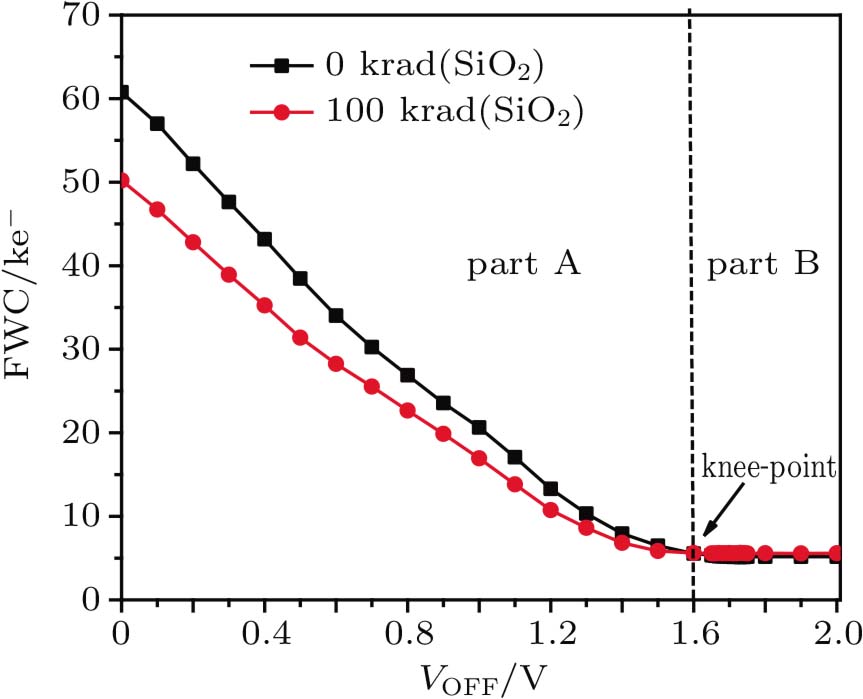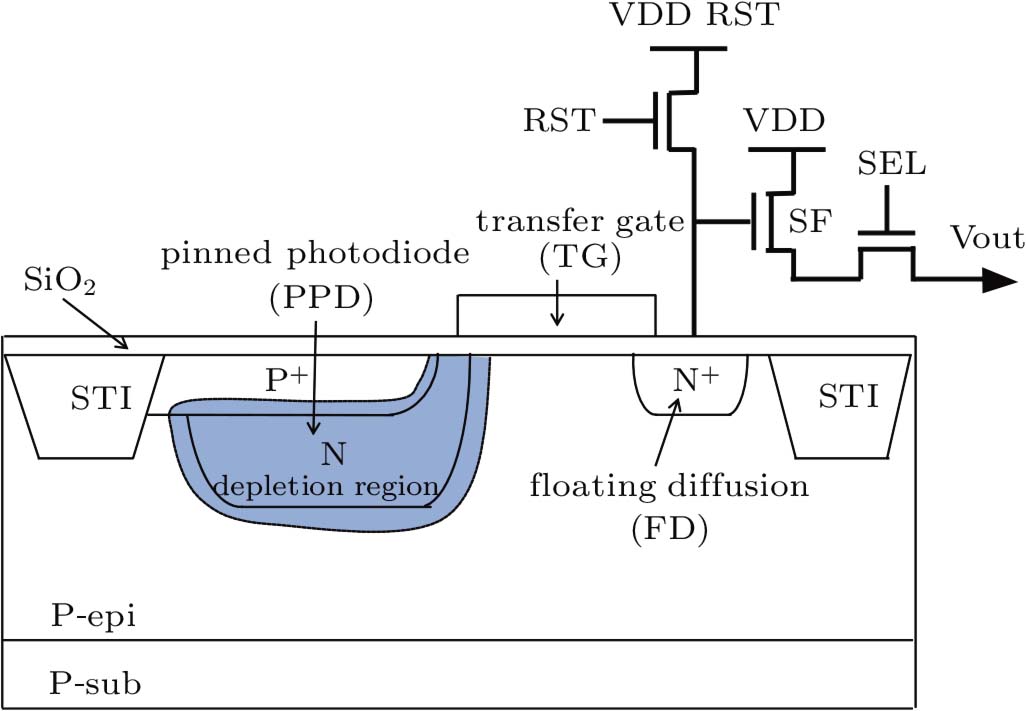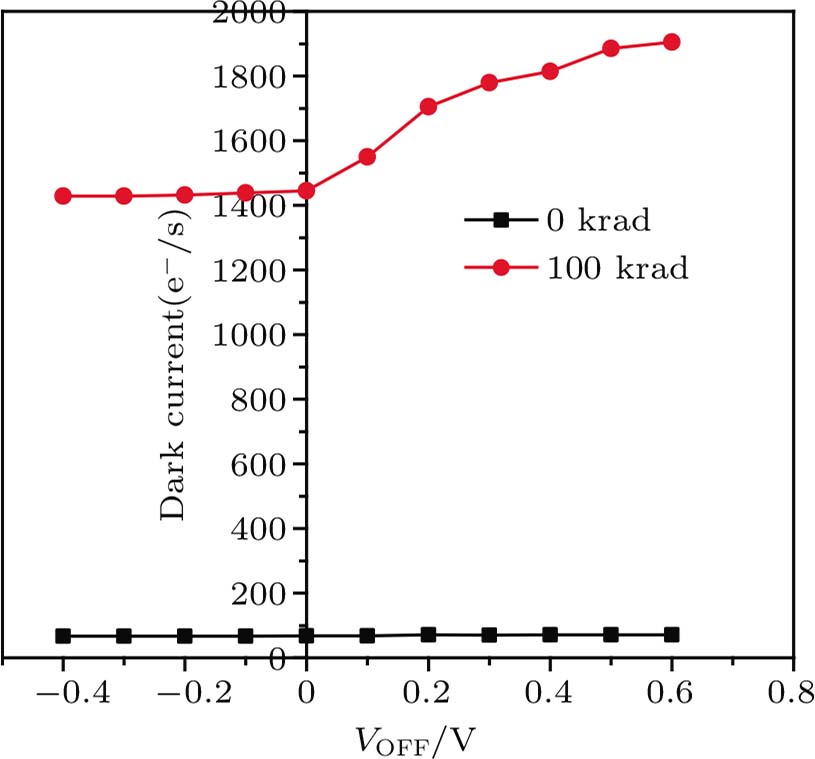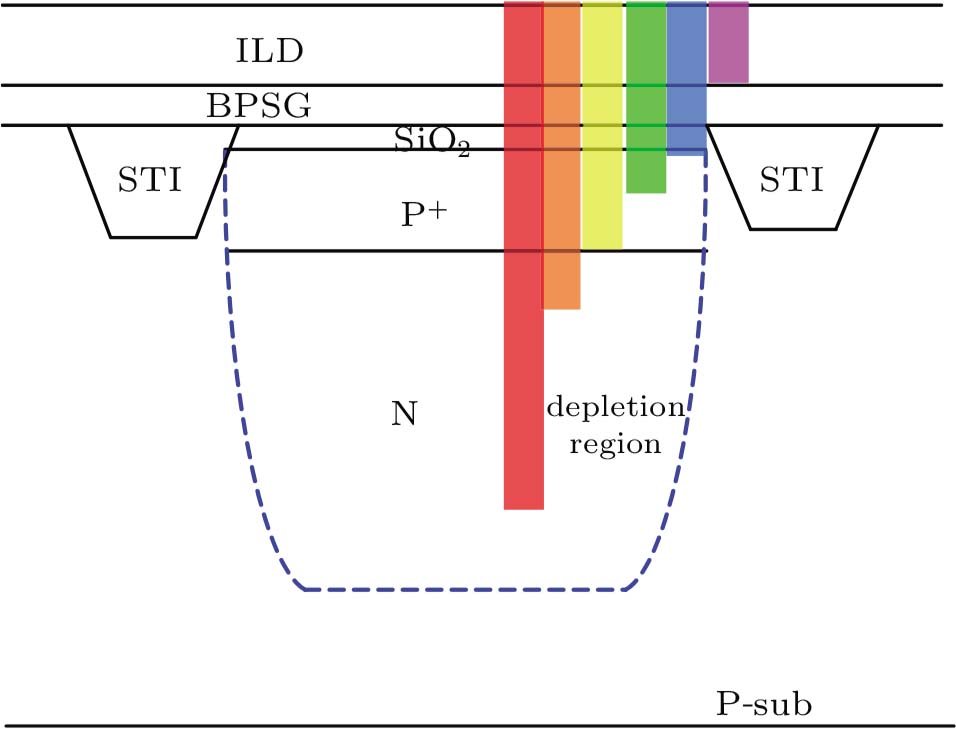† Corresponding author. E-mail:
Project supported by the National Natural Science Foundation of China (Grant No. 11675259) and the West Light Foundation of the Chinese Academy of Sciences (Grant Nos. 2016-QNXZ-B-8 and 2016-QNXZ-B-2).
A pinned photodiode complementary metal–oxide–semiconductor transistor (CMOS) active pixel sensor is exposed to 60Co to evaluate the performance for space applications. The sample is irradiated with a dose rate of 50 rad (SiO2)/s and a total dose of 100 krad (SiO2), and the photodiode is kept unbiased. The degradation of dark current, full well capacity, and quantum efficiency induced by the total ionizing dose damage effect are investigated. It is found that the dark current increases mainly from the shallow trench isolation (STI) surrounding the pinned photodiode. Further results suggests that the decreasing of full well capacity due to the increase in the density, is induced by the total ionizing dose (TID) effect, of the trap interface, which also leads to the degradation of quantum efficiency at shorter wavelengths.
Complementary metal–oxide–semiconductor transistor (CMOS) active pixel sensors (APSs), due to their low power consumption, high-level integration, and low cost, have reached or even exceeded charge-coupled devices (CCDs) in the performance level.[1,2] Compared with 3 transistor (3T) CMOS APS, a p+ layer is added on the top of the n-layer of a normal photodiode in pinned photodiode (PPD, 4T) CMOS APS, which is used to solve the interline transfer lag problem and thermal noise problem, and reduce the dark current from the surface. Unlike the CCDs, the PPD CMOS APS does not suffer charge transfer degradation. Since PPD CMOS APS is the most promising sensor for high performance imaging applications at a low light level and in an extreme environment (especially for space, scientific, nuclear, medical, and military instruments applications), radiation damage is our primary concern.[3]
The effects of radiations damage on 3T CMOS image sensors have been widely studied.[4–6] On the contrary, the radiation effects on 4T pixels have not been very well understood yet. There are significant differences among the total dose damage mechanisms of CMOS APS with different pixel structures. The previous studies indicated that gamma irradiation leads the quantum efficiency to increase for 3T APS,[7] while the present work shows that the gamma irradiation can cause the quantum efficiency to decrease for 4T APS.
The aim of this work is to provide an overview of the degradation in 4 T CMOS APS induced by Cobalt60 irradiation. In this paper, we study the main origins of the increase in dark current in a pinned photodiode caused by the total ionizing dose effect at 100 krad (SiO2). Moreover, the degradation mechanisms of full well capacity and quantum efficiency are also analyzed.
The PPD CMOS APS was a scientific image sensor with 2048 by 2040 pixels, manufactured using 0.18-μm standard CMOS technology. The sensor was operated in rolling shutter mode. Figure
Considering that a sensor has 400 million pixel unites, a sample has been exposed to 60Co gamma ray up to 100 krad (SiO2) at a dose rate of 50 rad (SiO2)/s. During the irradiation, the sensor was unbiased with all pins grounded, and gamma irradiation was performed using 60Co gamma source at the Xinjiang Technical Institute of Physics and Chemistry in Urumqi, China. All parameters were measured immediately after irradiation at room temperature (around 23 °C) in the case of annealing.
In order to discriminate the contributions of the two kinds of defects, trapped oxide charges and interface states, after gamma irradiation, annealing tests at 100 °C and 200 °C for 168 hours were performed, respectively.
The dark signal is defined as the carriers generated in the potential wells under the pixel in fully dark conditions. Figure
When an APS is irradiated by gamma rays and protons, several mechanisms induce the dark current to increase. Displacement damage produced by gamma rays is negligible, leading to the bulk dark current remaining unchanged. Damages can cause a build-up of traps at the interface (usually called Si/SiO2 interface traps), which induces the current to increase near the depleted region in the photodiode. As a consequence, trapped oxide charges will change the distribution of the electric field and modify the Si/SiO2 interface potential, which can cause the depletion region to extend and thus strongly affecting the generation rate of the charge in the neutral state. The distribution of the origin of dark current in PPD CMOS APS has been proposed in previous work[8–10] and is shown in Fig.
In this paper, we simply distinguish the contributions of the different origins of dark current. We believe that the dark current coming from the dielectric can be ignored after the highest TID only at 100 krad (SiO2). The main sources come from the interface states located at TG and STI, which surround the PPD. The number of dark electrons from the TG edge strongly depends on the bias. When VOFF is set to be at negative bias, the TG is accumulated with holes which recombine with dark electrons generated from interface defects and fill the traps caused by γ -irradiation around the TG.[11] If the dark current generated in the TG is suppressed by using a negative bias, the remaining dark current mainly comes from STI.
As shown in Fig.
The maximum output voltage swing of an image sensor can be limited either by the saturation of the readout circuit or by the full well capacity (FWC) of the PPD.[12] Therefore, the FWC is one of the main parameters determining the dynamic range of the image sensor. The FWC in the 4T pixel structure is defined as the maximum charge that can be stored in the photodiode capacitor and can be roughly approximated by Q = (Vpin − VOFF) × CPPD, where Vpin and CPPD are the photodiode voltage and capacitance respectively when the photodiode is fully depleted.[13]
Figure
For the detailed measurement of FWC, VOFF is swept from 0 V to 2 V, with the integration time and light intensity fixed. The results of this measurement are shown in Fig.
 | Fig. 7. (color online) Variations of FWC with VOFF for VOFF voltages ranging from 0 V to 2 V before and after irradiation. |
 | Fig. 8. (color online) PD depletion region expanding after irradiation as illustrated by TCAD simulation.[14] |
When the PPD is illuminated by a source of light on the top surface, the absorption of the incoming photons produces photo-electrons, for energy higher than the band gap of silicon. Quantum efficiency (QE) is an important parameter of the image sensor, characterizing the ability to convert photons of a certain wavelength into an effective electrical signal.[15]
The curve below displays the variations of QE with wavelength for visible spectrum (400 nm–1000 nm), as shown in Fig.
As shown in Fig.
Figure
The radiation effects on PPD CMOS active pixel sensor caused by γ-ray are investigated. We study the degradation in the dark current, full well capacity, and quantum efficiency due to total ionizing damage effects.
After being exposed to irradiations up to 100 krad (SiO2), the device has a performance penalty. We find a considerable increase in the dark current, which is generated mainly by traps located at the STI interface and induced by damage at the same time, and the dark current from TG at a nominal VOFF of 0 V is negligible. The pinning voltage of the photodiode shows no changes with TID; on the contrary, the full well capacity is observed to decrease due to photodiode capacitance decreasing. The decrease of quantum efficiency at shorter wavelengths can be explained as that the increase of surface interface trap density results in the increase of photo-generated carriers recombination rate and the decrease of effective diffusion length.
Finally, most of the previous experiments have been performed on devices grounded during irradiation, which may hide some effects that could be enhanced by the local electric field during exposure to the irradiation. In order to investigate the potential biasing effects, more PPD CMOS sensors need to be irradiated by γ-ray under different biasing conditions.
| [1] | |
| [2] | |
| [3] | |
| [4] | |
| [5] | |
| [6] | |
| [7] | |
| [8] | |
| [9] | |
| [10] | |
| [11] | |
| [12] | |
| [13] | |
| [14] | |
| [15] | |
| [16] | |
| [17] |










